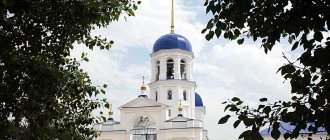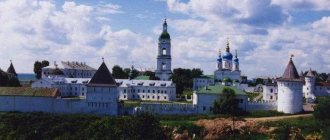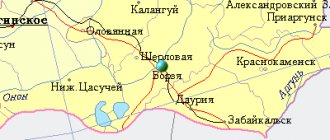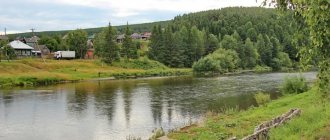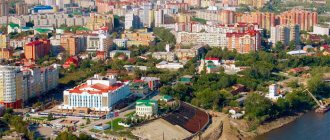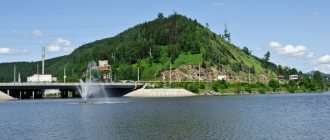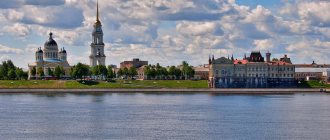SALAIR , a city of urban subordination in the southwest of the Kemerovo region, is located on the eastern slope of the Salair Ridge, 25 km from the Guryevsk railway station, 210 km south of Kemerovo. From the beginning of the 18th century. - factory settlement; since 1941 - a satellite city of Guryevsk. Population (thousands of people): early 1830s. — 4.0; 1959 - 17.3; 1967 - 16.0; 1970 -13.6; 1979 - 11.2; 1989 - 11.4; 1998 - 10.9; 2002 -9.5; 2007 - 9.1.
Originated at the beginning of the 18th century. as a mining village near a silver mine, by the beginning of the 19th century. has become the administrative, economic and cultural center of the region, the largest settlement in the Kuznetsk district. By this time, a hospital, a mining school, and a church had been built. The history of Salair is connected with the development of the city-forming enterprise - the Salair Mining and Processing Plant, which was awarded the Order of the Badge of Honor (1982) in honor of the 200th anniversary for its services in the development of non-ferrous metallurgy. Social and cultural sphere: 3 secondary schools, a palace of culture.
Lit.: Salair silver mines // Encyclopedic Dictionary / Ed. F. Brockhaus and I.A. Efron. St. Petersburg, 1900; Sorokin M.E. Salair. Kemerovo, 1984; From the history of Salair, 1780-2007. Kemerovo, 2007.
V.A. Volchek
Where is the Salair holy spring located?
The holy spring is located near the city of Salair. Salair is a city in the west of the Kemerovo region, which is part of the Guryevsky municipal district. The location of the city is very interesting. It is located on the eastern slope of the Salair Ridge, a low-mountain chain that stretches through the Altai Territory, Kemerovo and Novosibirsk regions. The city is located almost near the western border of the Kemerovo region, surrounded by magnificent Siberian nature.
General information about the city of Salair
The city of Salair, founded in 1626, is located in the heavily destroyed ancient mountains or on the Salair ridge. As for the weather, the city is located in a sharply continental climate zone. This climate caused a long cold and windy winter period with an average January temperature of minus 17°C. Summer in the city is sultry and hot, but, unfortunately, not long. In green, surrounded by forest areas, Salair, according to the latest census, has a population of 7,985 people. The life of the local population, as well as the history of the city itself, is connected with the mining and processing plant.
Church of the Great Martyr Panteleimon (the village of Bekovo)
On the way to the Salair holy spring, we stopped in the village of Bekovo, which is located between the cities of Belovo and Guryevsk. In it we visited the local church of the Great Martyr Panteleimon.
Since it was Sunday morning, the service in the church was just ending. In this regard, it had a significant number of parishioners from the local population, a significant part of which were Teleuts. The Church of the Great Martyr Panteleimon is quite old. It was built in 1890. But her story is very tragic. During the years of Soviet power, the church was closed, and there was a lot of things in its premises. There was a tannery, an incubator, an educational school and a DOSAAF school. It was only in the first half of the 90s that the church was repaired and began holding services again.
History of the formation of the city of Salair
Thus, the first small settlement in the territories of the modern city of Salair arose back in 1626 on the Malaya Tolmovaya River. The history of the formation of the city is directly related to deposits of valuable minerals. In the second half of the 18th century, silver ore was discovered on these lands. Construction of the mine began, premises for workers and houses for the management staff were erected. The Salair mine appears. Soon gold was discovered in the territories. A whole gold rush has begun, and mines are appearing. During the Soviet period, the territory of the modern city was explored in detail for the presence of minerals. Salair begins to increase ore production. And in the 20th century it received the status of a working village. More residential buildings appeared, schools and churches arose. It must be said that the history of the city is closely connected with the formation of the Salair mining and processing plant.
Temple of the Supreme Apostles Peter and Paul (city of Salair)
Next we went to the city of Salair itself. It is worth noting that the path to the holy spring does not pass directly through the city, so we had to make a small detour. In Salair we visited the temple of the Supreme Apostles Peter and Paul.
This temple is one of the oldest in Kuzbass. It was built back in 1803. In its original form, it was a wooden prayer house. But in this form it did not last long. A few years later the house burned down. Then a wooden church was built. But it also burned several times and was rebuilt again. Construction of the temple in its current form was completed in 1907. In Soviet times, the Church of the Supreme Apostles Peter and Paul also had to go through many difficult times. The temple was destroyed. As a result, the building fell into disrepair. As a result, it was threatened with the possibility of being transferred to other buildings. However, this did not happen. Thanks to the efforts of caring people, the temple was restored. As a result, in 1991, the Church of the Supreme Apostles Peter and Paul was consecrated again.
It is worth noting that the Church of the Supreme Apostles Peter and Paul is really very beautiful. It is considered one of the main Orthodox attractions of the Kemerovo region and a must-see for adherents of Orthodox tourism. In Kuzbass it is perhaps even more famous than the island of Patmos in Altai.
Sights of the city of Salair
The life of the city is also connected with the House of Culture. It is there that artistic groups often perform, festive events are held, and by signing up for a club, everyone can engage in creative work here.
The city has a children's music and art school, an arts center, and library doors are always open.
The Salair Holy Spring has become a real place of pilgrimage for tourists. The water in it actually has healing properties, which is also due to the high content of silver ions.
The local nature deserves special attention and admiration. It mainly attracts ski lovers. Here everyone will find something suitable for themselves. Beginner skiers will practice on small slopes, and masters can visit a special slalom track.
Salair holy spring
After visiting the Church of the Supreme Apostles Peter and Paul, we finally got to the main goal of our trip to Salair. The holy spring was located directly behind the large and convenient parking lot where we stopped.
Previously, there was just a spring here. But several years ago this area began to be improved and now it looks very cozy. And quite recently a temple was built here in honor of the icon of the Mother of God the Tsaritsa.
In front of the temple there is a figure of St. Seraphim of Sarov.
Next is a well. Anyone can collect holy water there. And nearby there are swimming pools for those who want to take a dip. It is worth noting that the water in the baths is quite cold. Even though the weather was very warm on the day of our trip, the water was scaldingly cold.
In addition, there is a changing room next to the plunge pools. Among other things, there is a church shop and a charity canteen.
Also on the territory there is a cedar grove, founded on the initiative of the former governor of the Kemerovo region Aman Tuleyev in 2007. The grove is a gift from the Tuleyev family to the residents of the Kemerovo region, as evidenced by the inscription on the stone.
Cedars grow on the upper slope. The view of the grove is very picturesque.
There are walking paths between the trees. There are also gazebos for relaxation.
There is also a bridge of love and desires on the territory. You can make a wish on it and ring the bell. In addition, newlyweds traditionally attach locks to this bridge.
Tragedy of the Salair Temple
(The monument to Alexander II is lost forever)
The current Salair Peter and Paul Church took seven years to build (1900-1907). It was erected by stone craftsmen, residents of the neighboring Altai village of Zhulanikha. The construction was supervised by the noble master Rogov. “From all over the area, people carried chicken eggs in carts, generously adding them to the clay solution. And bricks of amazing strength emerged from this mess,” writes Mikhail Sorokin in the essay “Reborn from the Ashes.” Apparently, this is why the church stood for so many years.
Years passed. The revolution has passed. And then one day in 1919 the Reds came to the church, but most likely they were G.F.’s partisans. Rogov, known for their intransigence towards religion. They killed the priest and, tying him by the hair to a horse, dragged him several miles towards Guryevsk. Then they threw the tortured body into a pit. The corpses of the deacon and several parishioners, who were killed later, were also thrown there. As the old-timers said, it was in this place that a spring appeared, the water of which did not freeze even in severe frosts. A holy spring was subsequently discovered at this place, and later a chapel was built there, the area around was paved, and a causeway was built.
The Church knows many stories about how people saved ancient icons, precious to the Russian heart. One of them, painted back in 1908 on Mount Athos, survived due to the fact that parishioners managed to collect abandoned icons in the destroyed church. One old woman, fearing that her unlucky son would drink away one of the priceless relics, and there were attempts to do so, brought the icon to the revived temple late in the evening.
In Soviet times, the Petro-Paul Church shared the common bitter fate of all Russian churches. The bells were overthrown and sent to be melted down. The openwork forged crosses were literally turned inside out “with meat.” They were reforged onto axles for carts. In this regard, I would like to provide one piece of evidence. Belovchanin A.S. Kotov was born and raised in Salair. He remembers that his father told him a curious episode. When they decided to remove the crosses on the domes, they found people willing to do this barbaric task only for a lot of money. However, it was possible to break out the crosses only on small domes. It was not possible to immediately remove the cross from the high bell tower. The volunteers fell from the dome and fell to their deaths.
And how many times have they encroached on the amazingly beautiful bars on the windows, the work of the glorious Gavrilov and Guryev blacksmiths. And although no one interfered with the fanatics, each time the barbarians had to retreat. This is how the window bars were thoroughly embedded in the monolithic stone baked over time.
The priest, Father Sergius Mosolov, a graduate of the Moscow Theological Seminary, put a lot of effort and energy into the revival of the temple. He gave me a rare photograph from 1896. It depicts the moment of the opening of the monument to Alexander II. The history of the Salair temple is generally replete with many mysteries and ambiguities. One of them relates to the appearance near the church of a huge bronze monument to Tsar-Liberator Alexander II (1855-1881).
The Emperor had never been to our area, but the fact that Alexander abolished serfdom on February 19, 1861, introduced him to the rank of especially revered persons of the Romanov dynasty. On the occasion of the 50th anniversary of this event, funds were being collected in all cities and villages for monuments to the monarch-liberator. And in 1911, bas-reliefs, busts and other sculptural images of Alexander II began to appear everywhere. Monuments were built depending on the means - sometimes from metal, sometimes from plaster, and sometimes even from wood. In Salair, everyone was surprised by the fact that long before the general wave of immortalization of the royal person, a bronze monument was erected in a distant mining village. The photo shows that the base, entwined with flowers, is decorated with a large letter “A”. Below you can see a dash in the form of a unit. This circumstance misled Father Sergius. He put forward the version that it could be a monument to Alexander I, the conqueror of Napoleon. Now it is difficult to say what this dash meant, but there is no doubt that the monument to Alexander II was erected in Salair.
This is confirmed by numerous archive materials. It should be noted that the unknown author of the monument achieved a portrait resemblance to Alexander II. Bronze Alexander was quite impressive - the total height of the monument reached four meters. The full-length figure of the king was cast so skillfully and accurately that every feature of his face and uniform was clearly visible. The monument was surrounded by a forged fence.
A former student of the Salair school, Cherdantsev, witnessed the Rogovites’ raid on Salair in 1919. A decade later, he wrote: “The partisans tried to steal the monument to Alexander II, but they couldn’t, so they took the fence gate and hung it around his neck, ordering it not to be removed. So Alexander stood with the gate on his neck for two days, until the Kolchak police arrived from Bachat and removed them. The Bachat militia under Kolchak was commanded by 18-year-old G.M. Milovanov, known for his brutal reprisals against adherents of Soviet power. During Soviet times, the monument was pulled down by a tractor and dragged away to be melted down.
Geology and climate
The northernmost spur of the Altai-Sayan mountain system, the Salair Ridge, enters the Iskitimsky, Toguchinsky and Maslyaninsky districts.
Once upon a time, millions of years ago, Salair raised its peaks high, was a real mountainous country, but everything in this world is aging, even the mountains, and now the ridges can only be called mountains with a stretch. However, on Salair there is the highest point of the Novosibirsk region - 502 meters above sea level, mountain rivers rustle on the rifts, there are rocky outcrops, and in some places there are even caves.
For many, the journey to Salair begins from the Novosibirsk - Leninsk-Kuznetsky highway. In the area of the village of Lebedevo, the northernmost peak of the Salair Ridge, Mount Ulantova, is clearly visible from this route. As a kind of outpost of Salair, it rises among the surrounding plains. If you drive further, soon the foggy outlines of the main massif of the Salair Ridge will appear on the horizon, rising like a wall against the backdrop of the surrounding meadows and steppes.
The populated areas of Salair are located mainly along river valleys. Most of the ridge is covered with impassable taiga and is practically uninhabited. In works of fiction about Siberia, for example, in the novel “Shadows Disappear at Noon,” these places are described as wild taiga jungles.
The climate of Salair is more humid and cooler than, say, the climate of the outskirts of Novosibirsk. In summer it often rains here, after which the entire taiga is saturated with water and humid fumes.
The Salair ridge is composed of very ancient Paleozoic rocks, which in places, usually along river banks, emerge from under a thick cover of sedimentary deposits - clays, sandstones, shales.
The Salair ridge and the pre-Salair areas are quite rich in minerals. In the vicinity of the village of Peteni there is a well-known marble quarry in our region. This quarry looks peculiar - in the form of steps. Using special equipment, marble blocks are cut from a common mass of stone. Marble from the Petenevskoe deposit has different colors and is famous for its quality.
But Salair is best known for its placer gold. Almost all rivers of Salair are gold-bearing. The population of these places has long been engaged in gold mining. The historical center of gold mining on Salair is the village of Yegoryevskoye, located in the picturesque valley of the Suenga River. The entire almost 200-year history of this village is connected with gold mining. Over the entire period of use of placers in the Yegoryevsky gold-bearing region alone, more than 10 tons of precious metal were mined. Currently, industrial gold mining is carried out on the Suenga and its tributaries. A special technical structure is designed for this - a dredge.
Unfortunately, gold mining leads to serious environmental problems. Many picturesque rivers of Salair. For example, Dredge Tiles are now disfigured by the activities of miners.
Hundreds of streams and rivers run along the slopes of the Salair Ridge, among stones and shady taiga thickets. River valleys are the most interesting and picturesque places in Salair.
Rivers
The main river of the Salair ridge, flowing through its very heart, is Berd. The Berdi riverbed is winding and replete with long sandy reaches. The current is mostly calm.
The second largest Salair river is Suenga. Suenga is also very picturesque. There are often stormy riffles on it. Grayling is found in Salair rivers. This fish is typical for mountain rivers.
Flora
A number of plants rare for Siberia are found on Salair. In spring, the slopes of the Salair Ridge are a luxurious carpet of primroses. The snow has not yet completely melted, but from under last year’s foliage wonderful flowers are already making their way towards spring - kandyk, Altai anemone, gooseberry, holatka, lumbago.
European hooffoot is a relict plant that has been preserved on the Salair Ridge since the era when the climate in Siberia was much milder and deciduous forests predominated.
The taiga is also very beautiful in autumn. The evergreen color of pines and firs is complemented at this time by the yellow, orange and red tones of deciduous trees. Here and there, bright lights of rowan, raspberry, rose hip, and currant fruits shine among the foliage.
Large amounts of snow in winter and humid Salair summers contribute to the gigantic growth of grasses. Even ordinary plants sometimes reach enormous sizes here and form impenetrable thickets - real grass jungles.
There are forests of different types on Salair. Most often these are mixed forests. In some places they are dominated by light, cheerful birches, and sometimes there are pine forests. Salair is characterized by vast areas of pure aspen forests.
In hard-to-reach places, dense, impassable taiga, consisting of fir and aspen, still remains. In Siberia, these gloomy dark coniferous forests are called chenoya or chernovaya taiga. In such a forest, dampness is always felt and twilight prevails - here is the kingdom of mosses, ferns and lichens. The mob is gloomy, gloomy, littered with dead wood. These are typical bear areas. It seems that the owner of the forest himself is about to appear from the thicket.
The most beautiful and valuable areas in Salair are areas of pure fir forest. In recent decades, fir forests have suffered greatly from the activities of logging companies. There are practically no large areas of fir left. One of the islands of fir forest has been preserved in the vicinity of the former village of Kotorovo. The natural monument “Black Forests of the Salair region” was organized here.
An ecological trail has been laid across the territory of the natural monument, which is used by scientists studying the biocenoses of the Salair taiga.
Fauna
In this untouched corner of the black taiga, you can find interesting representatives of the fauna, such as this boreal owl.
The fauna of Salair is very rich. First of all, insects attract attention - the ubiquitous ants, forest bugs, bright and fancy butterflies. A number of rare insects are found on Salair, for example, the Apollo butterfly, listed in the Red Book of Russia. In the taiga, on dead tree trunks, the work of longhorned beetles and bark beetles is clearly visible. They tirelessly recycle the trunks of dead trees.
The moist Salair taiga, rich in herbaceous vegetation, creates ideal conditions for the existence of the taiga tick, a carrier of encephalitis. There are a lot of ticks on Salair. What can you do - taiga is taiga! But in a real taiga there should be bears. Sometimes you can even see them. You shouldn't linger here for long - the mother of the bear cub may be nearby. Bats can be found in caves and hollows. All species of bats living in our region are listed in the Red Book. Scientists are studying these peculiar animals and developing measures to protect them.
The Salair taiga is home to an abundance of birds. More than a hundred species of birds live and breed here. The blue nightingale is one of them. He made his nest at the edge of the forest. The female will incubate a clutch of 5 greenish eggs for about two weeks until the chicks hatch.
In the second half of summer, the chicks leave the nests, become fledglings, begin an independent life, and the number of birds in the Salair taiga becomes much larger. At this time, you can hear the melodic roll call of hazel grouse. Finches and long-tailed tits search for insects in the treetops. And warblers, warblers and warblers search for insects in the grass and on the inflorescences of umbrella plants.
In winter, the taiga is like a fairy tale. Slender fir trees are covered with sparkling fluffy snow. At such a time, it seems that everything in the taiga has fallen asleep. But even in this harsh time, many animals are active. Squirrels and crossbills deftly remove seeds from the cones of coniferous trees. Pine also provides food for the largest taiga birds – wood grouse. All winter they feed on pine needles. A great gray owl catches careless mice that have gone about their business from under the snow. Lynx prefers hares, but it is not always possible to catch them. Wolves are also found on Salair.
The nature of Salair is beautiful at any time of the year. But she needs protection. A number of specially protected natural areas have currently been created on the territory of the Maslyaninsky and Toguchinsky districts, but their number needs to be increased.
Caring for the unique nature of the Salair Ridge is a guarantee that its pristine beauty and wealth will be preserved for future generations.

